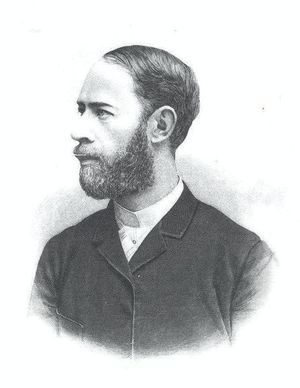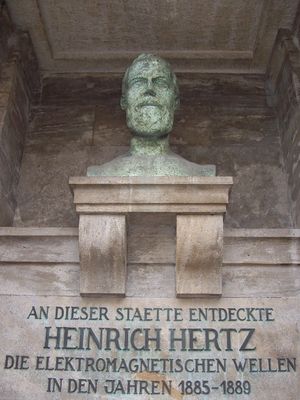Heinrich Hertz
- Birthdate
- 1857/02
- Death date
- 1894/01/01
- Associated organizations
- Karlsruhe’s Technische Hochschule
- Fields of study
- Radio
Biography
This article was initially published in Today's Engineer on July 2007
The electromagnetic spectrum and its commercial exploitation today seem as commonplace as the air that surrounds us. Yet there was a time in the not too distant past when the very concept of the electromagnetic spectrum was unknown. When James Clerk Maxwell proposed the idea, first in the 1860s and then more fully in his 1873 Treatise on Electricity and Magnetism, it took almost two decades to gain widespread acceptance by the scientific and engineering establishment. In some quarters, it was actively resisted. The man whose elegant experiments finally transformed a contested theory into a universally accepted model of reality was Heinrich Hertz, a brilliant German of Jewish origin who was prevented only by his untimely death from revolutionizing more than one major area of physics. His accomplishments earned him the posthumous honor of having his surname designate the international unit of frequency, but behind “Hertz” the term lies the story of a fascinating, albeit brief, life.
Hertz was born in February 1857 into a wealthy, educated and incredibly successful Hamburg family. His father, a lawyer and politician, had converted from Judaism to Lutheranism upon marrying Heinrich’s mother, the daughter of a Lutheran minister. Two of Heinrich’s brothers would follow their father into law and politics; another would become a successful musician. His sister would marry a prominent artists, and a nephew, Gustav Hertz, would win the Nobel Prize for physics in 1925.
Through his short life, Heinrich was in constant motion both geographically and intellectually. Demonstrating an early aptitude for mathematics and science, he began by studying civil engineering in Hamburg. When he worked his way to Dresden (by way of Frankfurt), Professor Philipp von Jolly, later Max Planck’s doctoral supervisor, convinced him to switch to physics. In 1878, at the age of 21, he travelled to Berlin to study under Gustav Kirchhoff and Hermann Helmholtz. He received his doctorate, magna cum laude (quite rare in Berlin in those days), in 1880 — that is, within two years! Though he devoted his dissertation to the nature of electromagnetic induction in rotating conductors, his postdoctoral research as Helmholtz’s assistant focused on mechanical hardness and stress, a field in which he produced a number of seminal papers.
In 1883, Hertz pursued an opportunity to move up a rung on the academic ladder. He moved to the University of Kiel as a Privatdozent (Lecturer), where his research returned to electromagnetics. When a promised professorship was repeatedly delayed, he grabbed a full professorship at Karlsruhe’s Technische Hochschule in 1885. (Soon after he left Kiel, an assistant professorship was created there and was filled by Max Planck.) In 1886, he married Elizabeth, daughter of his colleague Dr. Max Doll. They would have two children, Johanna (born 1887) and Mathilde (born 1891). It was also at Karlsruhe that he conducted his groundbreaking work on electromagnetic waves.
When Hertz began his experiments on electrodynamics in 1886, little was known about Maxwell’s ideas on the continent of Europe, where Newtonian action-at-a-distance was still the only paradigm for understanding electrical and magnetic phenomena. Hertz upended this model by demonstrating that rather than being instantaneous, electromagnetic effects propagate at a finite speed. He was able to measure their wavelength and velocity and to explicate the nature of their reflection and refraction. Even more astoundingly, he discovered the existence of radio waves and the fact that they behave like light. By the end of the decade, Hertz’s validation of Maxwell’s electromagnetic field theory forced a conceptual revolution within the European community of theoretical physicists. His impact on Maxwell’s homeland, the British Isles, was equally dramatic, even if more controversial.
Unlike the situation in continental Europe, Maxwell’s work in electricity and magnetism developed a very strong following among theoretical physicists on the western side of the Channel. Though Maxwell himself had not actively sought to create a school around his theory, a small number of theoreticians scattered throughout Britain and Ireland immediately championed his reconceptualization of electricity and magnetism. Most electrical engineers, on the other hand, were very mistrustful. Like Edison and the others who had developed electrical technology to this point, they saw themselves as “practical men” who could dispense with the complex, mathematical theories advanced by the “Maxwellians.”
Sir William Preece exemplified the “practical” engineer’s disdain of theory. As one of the most prominent electricians of the day, Preece held considerable sway in the halls of industry and government. With no formal training in electricity and magnetism when he joined the Electric Telegraph Company, he learned by doing. When the British government put all telegraphy under the control of the Post Office, Preece was named its Chief Electrician. Born in 1834 and, like many of his contemporaries, convinced that experience rather than theory was the key to teasing out the technological opportunities in nature, he dismissed the younger Maxwellians as upstarts who had little respect for the empirical knowledge acquired by their elders. The scientific and technical arguments between Preece and the Maxwellians were often acrimonious. Even in the wake of Hertz’s breakthroughs, the generational debate in Britain truly ended only when the older engineers had died off, replaced by an academically trained cadre well versed in Maxwell’s mathematics.
Nonetheless, the Maxwellians greeted the news of Hertz’s experiments with great jubilation. Having put their theoretical abstractions on the bedrock of reality, Hertz’s results undercut the central objection raised by practical men like Preece. The Maxwellians themselves had been unsuccessful in their search for empirical evidence. It is perhaps ironic that the prize would go to a man from the continent, where Maxwell’s ideas were relatively unknown.
When he published his electromagnetic wave work in 1888, Hertz was instantly acknowledged as a leading physicist of the day. Offers poured in, and by 1889 he had moved to the University of Bonn. While there, he turned his attention back to mechanics, attempting to do for that field what Maxwell had done for electromagnetism: reduce it to a simple set of equations based, in this case, on only mass, time and length.
In 1892, he was diagnosed with first a head cold and then an allergy. His body was invaded by stubborn infections, and his condition progressively deteriorated. For nearly two years, he suffered through debilitating poor health. His spirits must have been very low, yet he always remained a playful father. Fearing that the end was near, he was determined to finish his treatise on mechanics. He faced death with courage, humility and a sense of duty. “Nothing is harder,” he wrote, “than a struggle fought no longer for victory, but merely so as not to give up without making a decent stand.” There was also calm acceptance. Three weeks before his death on 1 January 1894, he wrote to his parents:
“If anything should befall me, you are not to mourn; rather, you must be a little proud and consider that I among the especially elect destined to live for only a short time and yet to live enough. I did not desire or choose this fate, but since it has overtaken me, I must be content; and if the choice had been left to me, perhaps I should have chosen it myself.”
On New Year’s Day 1894, just weeks shy of his 37th birthday, he succumbed to blood poisoning. In a fitting end to his peripatetic life, he was returned to Hamburg for burial.
But Hertz’s story does not end with his death. At least intellectually, he continued to be a moving target. His assistant, Philipp Lenard, saw to the publication of Hertz’s magnum opus on mechanics, Die Prinzipien der Mechanik, in Neuen Zusammenhänge Dargestellt (The Principles of Mechanics Presented in a New Form) in 1895. His approach did not find widespread acceptance among physicists, who would soon focus their attention on quantum mechanics and relativity, but it was embraced by philosophers of science — in particular by Ludwig Wittgenstein, who had a background in engineering.
Hertz’s reputation was actively denigrated by the Nazis, who forced his wife and daughters to flee Germany because, despite strong Lutheran roots, they were considered Jews. One Nazi functionary attempted to overturn the use of the term “Hertz,” officially established by the IEC in 1930 to designate a unit of frequency (cycles per second). He suggested to the Physical Society of Berlin that instead they use the term “Helmholtz,” which would cleverly maintain the abbreviation “Hz” for the benefit of foreign colleagues. Despite the climate of anti-Semitism, German scientists refused to go along with this plan. “Hertz” remained and remains in use both in Germany and around the world.
For his role in setting the stage for the world-changing technologies that would emerge from the electromagnetic field concept, Hertz has also been recognized by the IEEE, which created the Heinrich Hertz Medal in 1987. It honors outstanding achievement in the field of radio waves.
References
Mathilde Hertz and Charles Susskind (eds.), Heinrich Hertz: Erinnerungeon, Briefe, Tagebücher/ Memoirs, Letters, Diaries (second enlarged bilingual edition), (San Francisco: San Francisco Press, 1977)
J.G. O’Hara and W. Pricha, Hertz and the Maxwellians, (London: Peter Peregrinus Ltd. And Science Museum of London, 1987)
Bruce J. Hunt, The Maxwellians, (Ithaca, NY: Cornell University Press, 1991)
Jed Buchwald, Creation of Scientific Effects: Heinrich Hertz and Electric Waves, (Chicago: University of Chicago Press, 1994)
Charles Susskind, Heinrich Hertz: A Short Life, (San Francisco: San Francisco Press, 1995).

